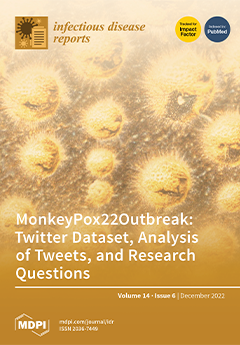The mining of Tweets to develop datasets on recent issues, global challenges, pandemics, virus outbreaks, emerging technologies, and trending matters has been of significant interest to the scientific community in the recent past, as such datasets serve as a rich data resource for
[...] Read more.
The mining of Tweets to develop datasets on recent issues, global challenges, pandemics, virus outbreaks, emerging technologies, and trending matters has been of significant interest to the scientific community in the recent past, as such datasets serve as a rich data resource for the investigation of different research questions. Furthermore, the virus outbreaks of the past, such as COVID-19, Ebola, Zika virus, and flu, just to name a few, were associated with various works related to the analysis of the multimodal components of Tweets to infer the different characteristics of conversations on Twitter related to these respective outbreaks. The ongoing outbreak of the monkeypox virus, declared a Global Public Health Emergency (GPHE) by the World Health Organization (WHO), has resulted in a surge of conversations about this outbreak on Twitter, which is resulting in the generation of tremendous amounts of Big Data. There has been no prior work in this field thus far that has focused on mining such conversations to develop a Twitter dataset. Furthermore, no prior work has focused on performing a comprehensive analysis of Tweets about this ongoing outbreak. To address these challenges, this work makes three scientific contributions to this field. First, it presents an open-access dataset of 556,427 Tweets about monkeypox that have been posted on Twitter since the first detected case of this outbreak. A comparative study is also presented that compares this dataset with 36 prior works in this field that focused on the development of Twitter datasets to further uphold the novelty, relevance, and usefulness of this dataset. Second, the paper reports the results of a comprehensive analysis of the Tweets of this dataset. This analysis presents several novel findings; for instance, out of all the 34 languages supported by Twitter, English has been the most used language to post Tweets about monkeypox, about 40,000 Tweets related to monkeypox were posted on the day WHO declared monkeypox as a GPHE, a total of 5470 distinct hashtags have been used on Twitter about this outbreak out of which #monkeypox is the most used hashtag, and Twitter for iPhone has been the leading source of Tweets about the outbreak. The sentiment analysis of the Tweets was also performed, and the results show that despite a lot of discussions, debate, opinions, information, and misinformation, on Twitter on various topics in this regard, such as monkeypox and the LGBTQI+ community, monkeypox and COVID-19, vaccines for monkeypox, etc., “neutral” sentiment was present in most of the Tweets. It was followed by “negative” and “positive” sentiments, respectively. Finally, to support research and development in this field, the paper presents a list of 50 open research questions related to the outbreak in the areas of Big Data, Data Mining, Natural Language Processing, and Machine Learning that may be investigated based on this dataset.
Full article






